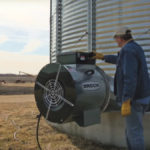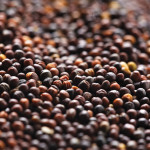Reading Time: 2 minutes There are a number of factors that determine the cost of drying grain. They include the type and size of the drying system, the amount of moisture to be removed, weather conditions during the drying period, and operating costs (fuel, electricity, repairs and maintenance, labour, shrinkage and hauling). “Knowing the costs of on-farm drying is […] Read more

Digging into the cost of drying grain
Having enough drying capacity is critical in a year like this one, but it still helps to have a handle on the costs

Dry grain while the sun shines — harnessing solar power for drying grain
Robert Baerg has gained some peace of mind with novel grain dryer
Reading Time: 6 minutes Robert Baerg was having coffee with a neighbour one rainy harvest about 15 years ago when they got to talking about their old grain dryer. It was a real headache, that dryer — chewing through horsepower to dry tough grain far too slowly, and then they still had to cool it. It took both neighbours […] Read more

Study aims to get a grip on pricey grain drying costs
Tens of millions are spent on grain conditioning in wet years but data on how to trim that cost is lacking
Reading Time: 4 minutes Alberta farmers learned the hard way last fall that wet harvests go hand in hand with grain drying — and the costs that come with that. But Alberta’s main crop commissions are looking for ways to trim those costs as harvests trend later and the need to condition grain goes up. “There has been an […] Read more
Grain drying study needs volunteers
Reading Time: < 1 minute Farmer volunteers are needed for a grain conditioning study being conducted by Team Alberta (the province’s wheat, barley, canola, and pulse commissions). The study will collect data on energy consumption and efficiency of grain drying and conditioning systems. Its findings will provide information for farmers regarding efficiencies; implementation or expansion of grain conditioning systems; and […] Read more

Drying grain may become the norm as harvests trend later
Natural air drying with supplemental heat hasn’t caught on in Alberta yet, but it soon could
Reading Time: 5 minutes Alberta farmers may need to get used to leaving grain in the field at harvest. “Harvest might be starting earlier, but poor weather during the harvest season is slowing down that last little bit of harvest, and there’s more and more crop being left in the field in October,” said Joy Agnew, program manager at […] Read more

Rebates on fuel taxes and the carbon levy
Reading Time: < 1 minute Most producers know about the fuel tax exemption on farm gasoline and diesel, but may be confused when it comes to propane, says provincial crop specialist Neil Blue. Only motive propane (used for vehicles) should have the 9.4-cent-per-litre Alberta fuel tax on it. If producers have been charged that tax for an on-farm use (such […] Read more

Keep ‘unpleasant surprises’ out of your grain bins this fall
Don’t neglect the basics when storing grain or oilseeds, says provincial crop specialist
Reading Time: 2 minutes A little preparation prior to harvesting can ensure worry-free winter crop storage, says a provincial crop specialist. “Warm or wet conditions at harvest and multi-staged crops are potential ingredients for storage problems,” said Harry Brook. “Take the time to monitor the stored grain’s condition and cool those bins down. Don’t get an unpleasant surprise when […] Read more

Don’t gamble by not aerating your canola
Uneven maturity means there’s more green seed this year, and that ups the risk of spoilage
Reading Time: 2 minutes You can lose a lot of money in a hurry, so watch for potential canola storage problems as fall transitions into early winter, says a provincial crop specialist. “Canola seed’s high oil content makes it very susceptible to deterioration in storage,” said Neil Whatley. “Safe, long-term canola storage is at or below eight per cent […] Read more

When storing grain, remember to SLAM
Paying attention to sanitation, loading, aeration, and monitoring is key to avoiding storage problems
Reading Time: 3 minutes This fall when you’re preparing your grain for storage, all you need to do is remember to SLAM. That’s short for sanitation, loading, aeration, and monitoring. The first step — removing any dust or debris from your bins before harvest — is “obviously important,” said Ryan Braun, Canadian sales manager for OPI, a grain storage […] Read more

